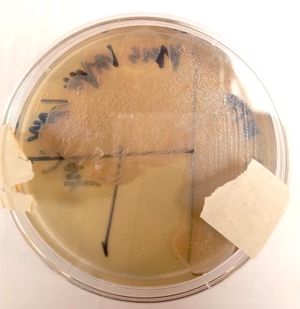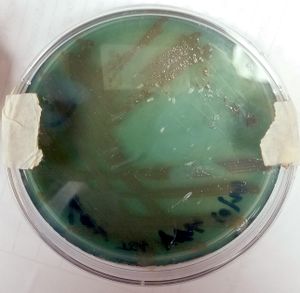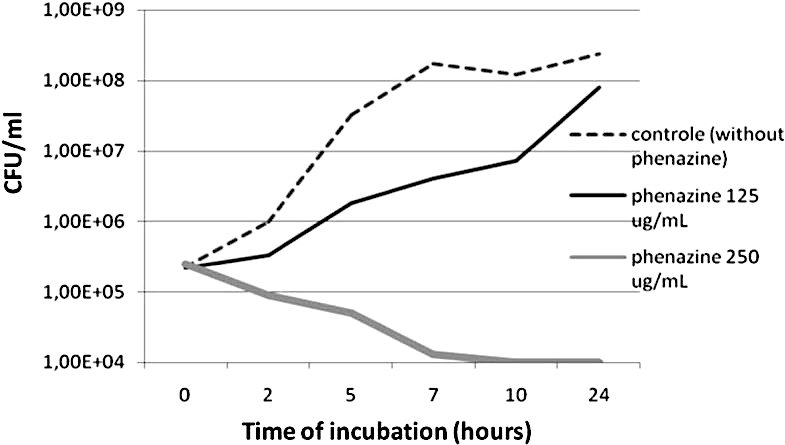Soil Unknown: P. aeruginosa: Difference between revisions
| Line 54: | Line 54: | ||
<br> | <br> | ||
<br> | <br> | ||
''' | '''Antimicrobial Activity''' | ||
<br> | <br> | ||
A study published in the ''Annals of Clinical Microbiology and Antimicrobials'' concluded that Pseudomonas aeruginosa-derived extracellular compounds such as phenazines have inhibitory effects against MRSA. A synergic effect was observed when combined with silver nanoparticles produced by Fusarium oxysporum (2). | A study published in the ''Annals of Clinical Microbiology and Antimicrobials'' concluded that Pseudomonas aeruginosa-derived extracellular compounds such as phenazines have inhibitory effects against MRSA. A synergic effect was observed when combined with silver nanoparticles produced by Fusarium oxysporum (2). | ||
Revision as of 19:42, 1 December 2017
Classification
| Domain | Bacteria |
|---|---|
| Phylum | Proteobacteria |
| Class | Gammaproteobacteria |
| Order | Pseudomonadales |
| Family | Pseudomonadaceae |
| Genus | Pseudomonas |
| Species Group | Pseudomonas aeruginosa group |
| Species | Pseudomonas aeruginosa |
Species
|
NCBI: Taxonomy |
| Genus species: | Pseudomonas aeruginosa |
|---|
Habitat Information
The organism was isolated from 1 gram of a soil sample gathered from a park in the Barton Creek Landing complex in Travis County. In general, P. aeruginosa can be found in soil, decaying organic matter, and a variety of moist environments, including swimming pools, hot tubs, sponges, washcloths, and contact lens solutions (1).
Description and Significance
Describe the appearance (colonial and cellular), possible antimicrobial activity etc. of the organism, and why the organism might be significant.
Appearance
P. aeruginosa colonies appear to be of small to moderate, irregular, pulvinate and smooth. When incubated at 30 degrees celsius, the colonies have a small amount of orange pigmentation. When incubated at 37 degrees celsius, the colonies have gray pigmentation, as well as blue-green extracellular pigmentation:
Antimicrobial Activity
A study published in the Annals of Clinical Microbiology and Antimicrobials concluded that Pseudomonas aeruginosa-derived extracellular compounds such as phenazines have inhibitory effects against MRSA. A synergic effect was observed when combined with silver nanoparticles produced by Fusarium oxysporum (2).
Strain PR3 of P. aeruginosa has been found to have antifungal properties, inhibiting both Candida albicans and rice blast fungus (3)
Significance of organism
Genome Structure
Describe the size and content of the genome. How many chromosomes? Circular or linear? Other interesting features? What is known about its sequence? Include S Ribosomal sequence that you obtained from PCR and sequencing here.
Cell Structure, Metabolism and Life Cycle
Interesting features of cell structure; how it gains energy; what important molecules it produces.
Physiology and Pathogenesis
Identifying biochemical characteristics and enzymes made
If relevant, how does this organism cause disease? Human, animal, plant hosts? Virulence factors, as well as patient symptoms.
Virulence factors
- Fimbriae and adhesions aid in attachment to host, as well as enabling biofilm formation.
- Capsule helps shield the bacteria from phagocytosis, and also aids in bacterial attachment and biofilm formation.
- Neuraminidase enzyme helps bacteria attach to host.
- Elastase enzyme breaks down IgA, IgG, degrades complement components, and breaks down elastic fiber.
- Lipid A component can trigger fever, blood clotting, inflammation, or shock.
- Exotoxin A and exoenzyme S inhibit eukaryotic protein synthesis.
- Pyocyanin pigment triggers the formation of reactive forms of oxygen, which damages host cells (1).
References
1. Bauman, R. W. (2015) Microbiology with Diseases by Body System, pp. 567, 570. Glenview, IL: Pearson.
2. Cardozo, V., Oliveira, A.,Nishio, E. Antibacterial activity of extracellular compounds produced by a Pseudomonas strain against methicillin-resistant Staphylococcus aureus (MRSA) strains. Annals of Clinical Microbiology and Antimicrobials. 2013. Volume 12:12.
3. Bajpai, Vivek K.; Shin, Seung Yong; Kim, Hak Ryul; Kang, Sun Chul. 2008. Anti-fungal action of bioconverted eicosapentaenoic acid (bEPA) against plant pathogens. Industrial Crops and Products. 27(1): 136-141.
4.
Author
Page authored by _____, student of Prof. Kristine Hollingsworth at Austin Community College.



